Occlusion in Bottom Intakes with Circular Bars by Flow with Gravel-Sized Sediment. An Experimental Study
Abstract
:1. Introduction
2. Experimental Setting
2.1. Physical Device
2.2. Sediment Experimental Tests with Racks Made of Circular Bars (m = 0.28)
2.3. Previous Studies of T-Shaped Bottom Rack Occlusion by Flow with Gravel-Sized Sediment
- Reduced void ratio according to rack occlusion, termed the effective void ratio, m’.
- Visualization of preferential occlusion area related to the streamline curvature.
- The most efficient longitudinal rack slope, which in T-shaped bars was 30%.
- Finally, a methodology was proposed to obtain the wetted rack length, taking into account the sediment transport and occlusion as well as its comparison with the lengths proposed by Krochin [6].
2.4. Methodology to Define the Effective Void Ratio
3. Results and Discussion
3.1. Sediment Tests with Circular Bars
3.1.1. Deposition of Gravels over Racks
3.1.2. Effective Void Ratio
3.2. Relation between Hydraulic Parameters at the Beginning of the Rack with Ratio m’/m
3.3. Comparison of Occlusion in Racks with Circular and T-Shaped Flat Bars
3.4. Methodology to Calculate the Effective Wetted Rack Length, Lm’, for the Design of Bottom Intakes Considering the Gravel-Sized Sediments
- Calculate L1m, the wetted rack length in the slit of two bars, considering the initial void ratio, m, by using Equation (2) coupled with Equation (3) in the case of circular bars or with Equation (8) in the case of T-shaped bars [17]:
- Calculate the effective void ratio from the proposed Equations (6) and (7) depending on the rack slope and velocity at the beginning of the rack, U0;
- Calculate L1m′, the wetted rack length in the slit of two bars, considering the effective void ratio that takes into account the clogging effects obtained, m, by using Equation (2) coupled with Equation (3) in the case of circular bars, or with Equation (8) in the case of T-shaped bars;
- Calculate Lm, i.e., the wetted rack length over a bar using the methodology of Garcia et al. [23].where q is the flow derived by the rack; Lm is the wetted rack length; m is the void ratio, is the mean discharge coefficient for each wetted rack length; g is the gravitational acceleration; and Hmin is the minimum energy head calculated as 1.5 hc, with hc being the critical depth in reference to the plane of the rack. Constants a and b in the case of the void ratio m = 0.28 adopted the values 1.45 and 0.05, respectively, in the case of circular bars, and 1.50 and 0.05 in the case of T-shaped bars [23]. Figure 5 presents the scheme of the different lengths described.
4. Conclusions
Author Contributions
Funding
Acknowledgments
Conflicts of Interest
Notations
| a, b | constant of adjustment depending on the shape of bars and the space between them in Equation (10) |
| b1 | space between bars |
| bw | bar width |
| CD | drag coefficient of gravels |
| mean discharge coefficient for energy head | |
| CqH | discharge coefficient for flow depth |
| Cq0 | static discharge coefficient |
| d50, d90, d10, dmin, dmax, d50c | characteristic diameters of gravels |
| f | percentage of rack occluded |
| g | gravitational acceleration |
| H0 | energy head at the beginning of the rack in reference to the rack plane |
| Hmin | minimum energy head obtained when the Froude number equals the unity, and there is critical depth |
| hc | critical depth |
| h0 | flow depth at the beginning of the rack |
| k | obstruction parameter defined as k = (1 − f) m |
| Lm | wetted rack length |
| Lm′ | effective wetted rack length considering rack occlusion |
| L1m | wetted rack length in the slit of two bars, considering the initial void ratio |
| L1m′ | wetted rack length in the slit of two bars, considering the effective void ratio |
| m | void ratio |
| m’ | effective void ratio considering rack occlusion |
| q1, q2 | specific approaching and rejected flow, respectively |
| U | mean velocity of the flow over the rack |
| U0 | mean velocity of the flow at the beginning of the rack |
| W | mean weight of the gravels deposited over the racks |
| x | longitudinal coordinate along the rack |
| υ | kinematic viscosity of water |
| ρ | density of water |
| θ | angle of the rack plane with the horizontal |
| drag force | |
| Re0 | Reynolds number calculated at the beginning of the rack |
References
- Lauterjung, H.; Schmidt, G. Planning of water intake structures for irrigation or hydropower. A Publication of GTZ-Postharvest Project. In Deutsche Gesellschaft für Technische Zusammenarbeit (GTZ) GmbH; GTZ: Bonn, Germany, 1989. [Google Scholar]
- Andaroodi, M.; Schleiss, A. Standardization of Civil Engineering Works of Small High-Head Hydropower Plants and Development of an Optimization Tool (No. LCH-BOOK-2008-026); EPFL-LCH: Lausanne, Switzerland, 2006. [Google Scholar]
- CELEC EP. Proyecto Mazar-Dudas (2003). Available online: https://www.celec.gob.ec/hidroazogues/proyecto (accessed on 6 July 2018).
- PROAGRO, Programa de Desarrollo Agropecuario Sustentable. Tirolesas Serie de Investigación Aplicada No 1 Criterios de Diseño y Construcción de Obras de Captación para Riego—PDF (2010). Available online: https://docplayer.es/20552716-Tirolesas-serie-de-investigacion-aplicada-no-1-criterios-de-diseno-y-construccion-de-obras-de-captacion-para-riego.html (accessed on 6 July 2018). (In Spanish).
- Drobir, H. Entwurf von wasserfassungen im hochgebirge. Österr. Wasserwirtschaft 1981, 33, 243–253. [Google Scholar]
- Krochin, S. Diseño Hidráulico; Escuela Politécnica Nacional: Quito, Ecuador, 1978. (In Spanish) [Google Scholar]
- Castillo, L.G.; García, J.T.; Carrillo, J.M. Experimental and numerical study of bottom rack occlusion by flow with gravel-sized sediment. Application to ephemeral streams in semi-arid regions. Water 2016, 8, 166. [Google Scholar] [CrossRef]
- Frank, J.; Von Obering, E. Hydraulische untersuchungen für das tiroler wehr. Bauingenieur 1956, 31, 96–101. (In German) [Google Scholar]
- Frank, J. Fortschritte in der hydraulic des sohlenrechens. Bauingenieur 1959, 34, 12–18. (In German) [Google Scholar]
- Brunella, S.; Hager, W.; Minor, H. Hydraulics of bottom rack intake. J. Hydraul. Eng. 2003, 129, 2–10. [Google Scholar] [CrossRef]
- Ract-Madoux, M.; Bouvard, M.; Molbert, J.; Zumstein, J. Quelques réalisations récentes de prises en-dessous à haute altitude en Savoie. La Houille Blanche 1955, 6, 852–878. (In French) [Google Scholar] [CrossRef]
- White, J.K.; Charlton, J.A.; Ramsay, C.A.W. On the design of bottom intakes for diverting stream flows. In Proceedings of the Institution of Civil Engineers; ICE Publishing: London, UK, 1972; Volume 51, pp. 337–345. [Google Scholar]
- Simmler, H. Konstruktiver Wasserbau; Technische Universität Graz, Institut für Wasserwirtschaft und konstruktiven Wasserbau: Graz, Austria, 1978. (In German) [Google Scholar]
- Bouvard, M. Mobile Barrages & Intakes on Sediment Transporting Rivers; International Association of Hydraulic Engineering and Research (IAHR) Monograph: Rotterdam, The Netherlands, 1992. [Google Scholar]
- Raudkivi, A.J. Hydraulic Structures Design Manual; International Association of Hydraulic Engineering and Research (IAHR): Rotterdam, The Netherlands, 1993; pp. 92–105. [Google Scholar]
- Carrillo, J.M.; García, J.T.; Castillo, L.G. Experimental and numerical modelling of bottom intake racks with circular bars. Water 2018, 10, 605. [Google Scholar] [CrossRef]
- Castillo, L.G.; García, J.T.; Carrillo, J.M. Influence of rack slope and approaching conditions in bottom intake systems. Water 2017, 9, 65. [Google Scholar] [CrossRef]
- García, J.T. Estudio Experimental y Numérico de los Sistemas de Captación de Fondo. Doctoral These, Universidad Politécnica de Cartagena, Cartagena, Spain, 2016. (In Spanish). [Google Scholar]
- Ahmad, Z.; Kumar, S. Estimation of trapped sediment load into a trench weir. In Proceedings of the 11th International Symposium on River Sedimentation, University of Stellenbosch, Stellenbosh, South Africa, 6–9 September 2010; pp. 1–9. [Google Scholar]
- Bina, K.; Saghi, H. Experimental study of discharge coefficient and trapping ratio in mesh-panel bottom rack for sediment and non-sediment flow and supercritical approaching conditions. Exp. Therm. Fluid Sci. 2017, 88, 171–186. [Google Scholar] [CrossRef]
- Noseda, G. Correnti permanenti con portata progressivamente decrescente, defluenti su griglie di fondo. Ricerca sperimentale. L’ Energia Elettrica 1956, 6-June, 565–581. (In Italian) [Google Scholar]
- Carrillo, J.M.; Castillo, L.G.; García, J.T.; Sordo-Ward, A. Considerations for the design of bottom intake systems. J. Hydroinf. 2018, 20, 232–245. [Google Scholar] [CrossRef]
- García, J.T.; Carrillo, J.; Castillo, L.G.; Haro, P.L. Empirical, dimensional and inspectional analysis in the design of bottom intake racks. Water 2018, 10, 1035. [Google Scholar] [CrossRef]
- Castillo, L.G.; García, J.T.; Haro, P.; Carrillo, J.M. Rack length in bottom intake systems. Int. J. Environ. Impacts 2018, 1, 279–287. [Google Scholar] [CrossRef]
- Drobir, H.; Kienberger, V.; Krouzecky, N. The wetted rack length of the tyrolean weir. In Proceedings of the IAHR-28th Congress, Graz, Austria, 22–27 August 1999. [Google Scholar]
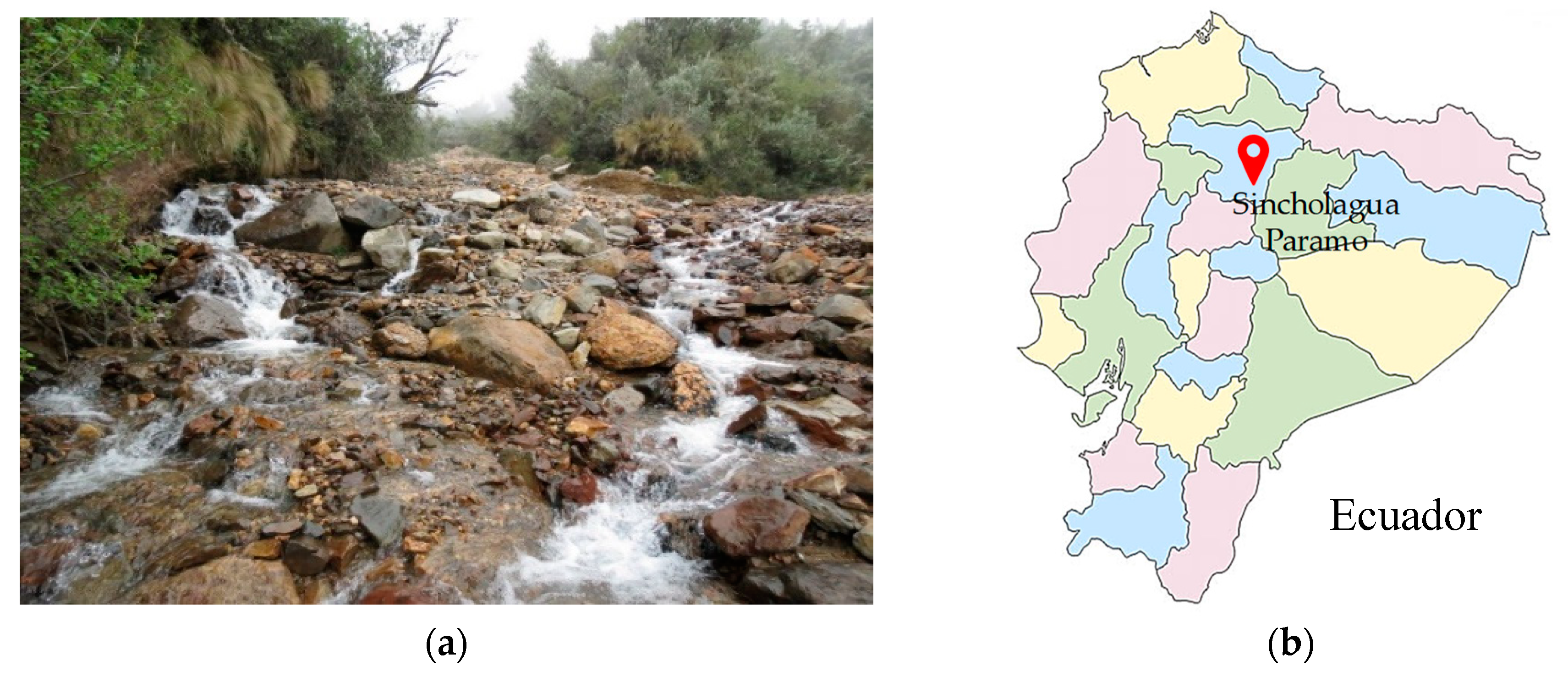


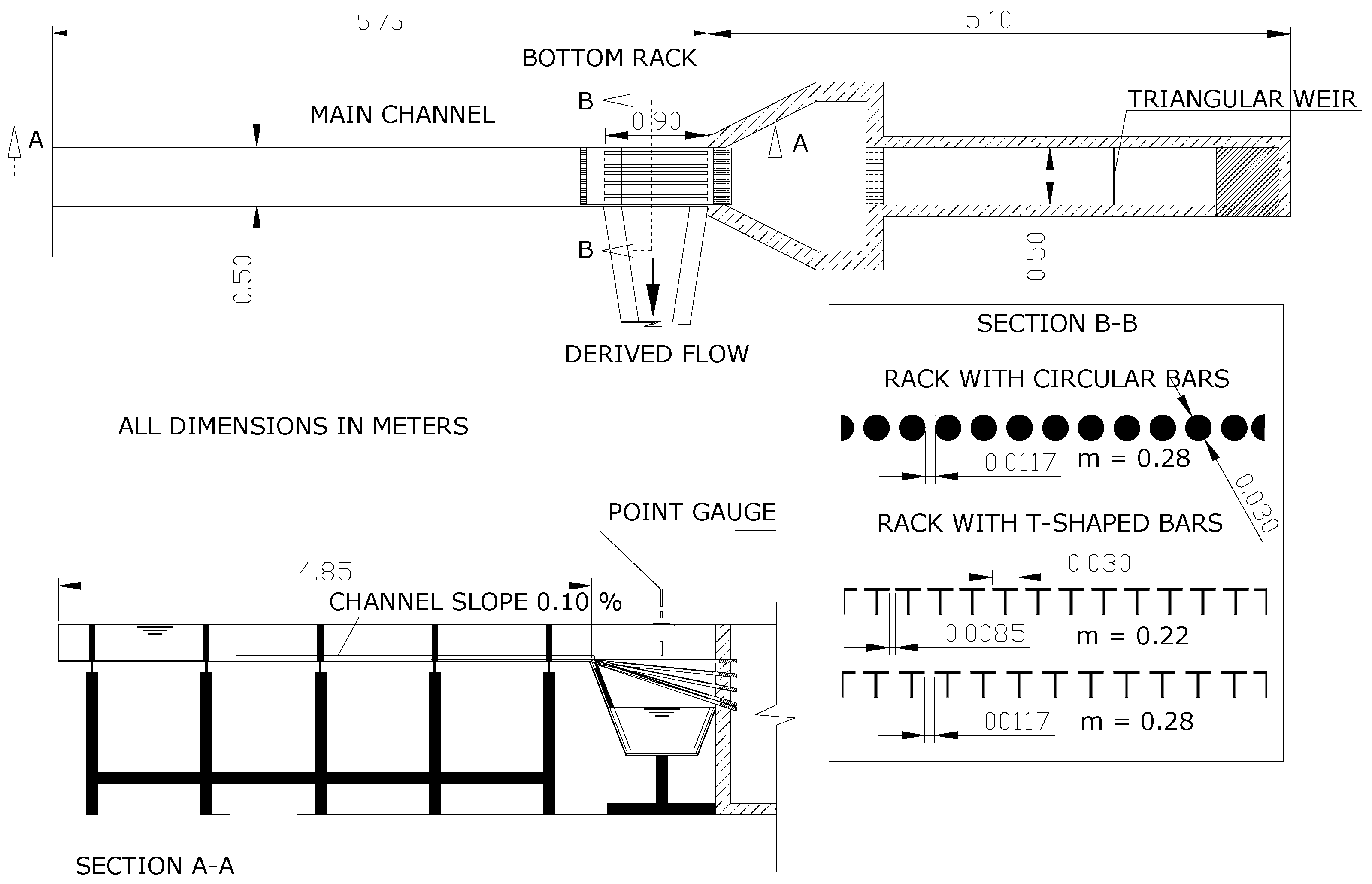
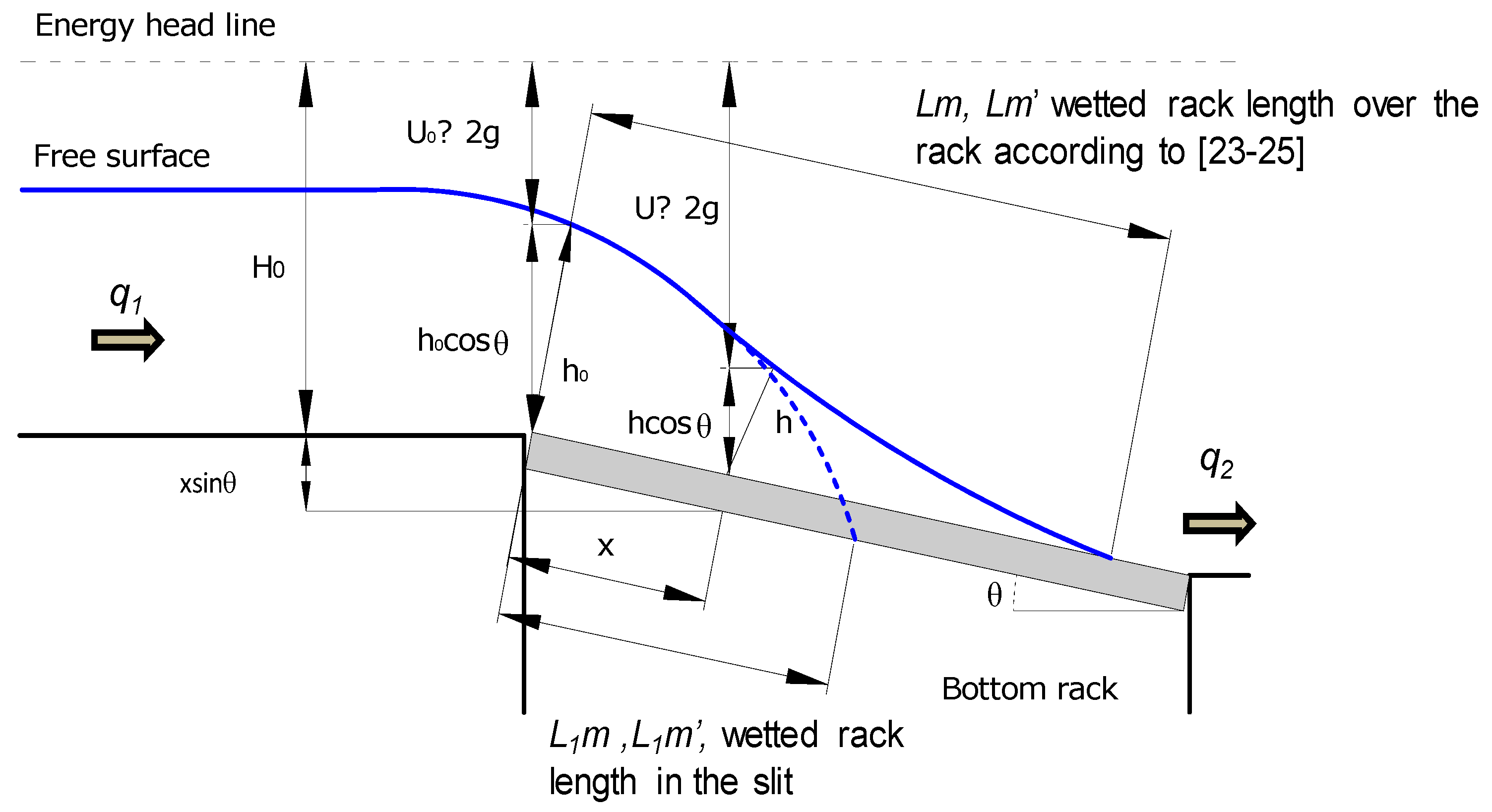


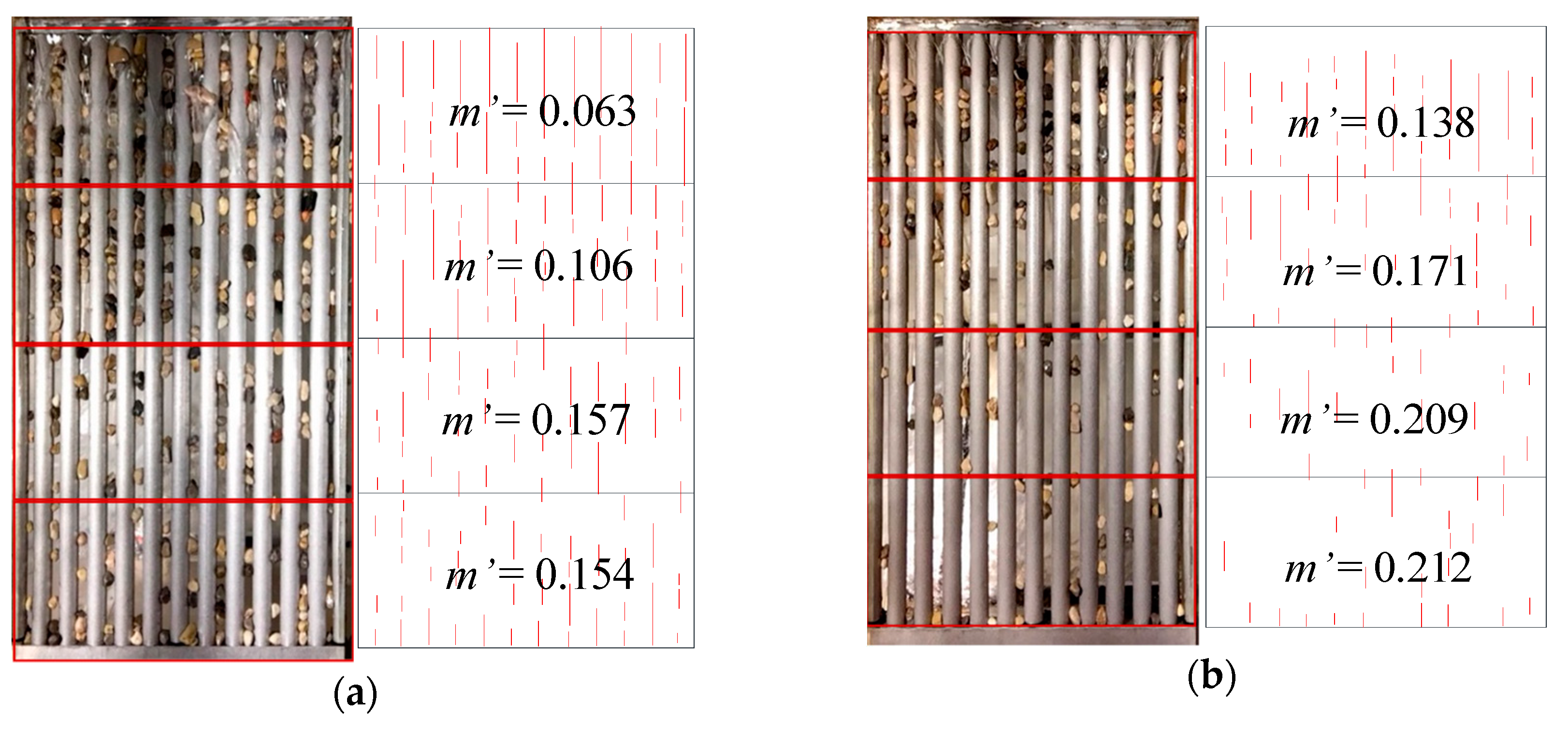

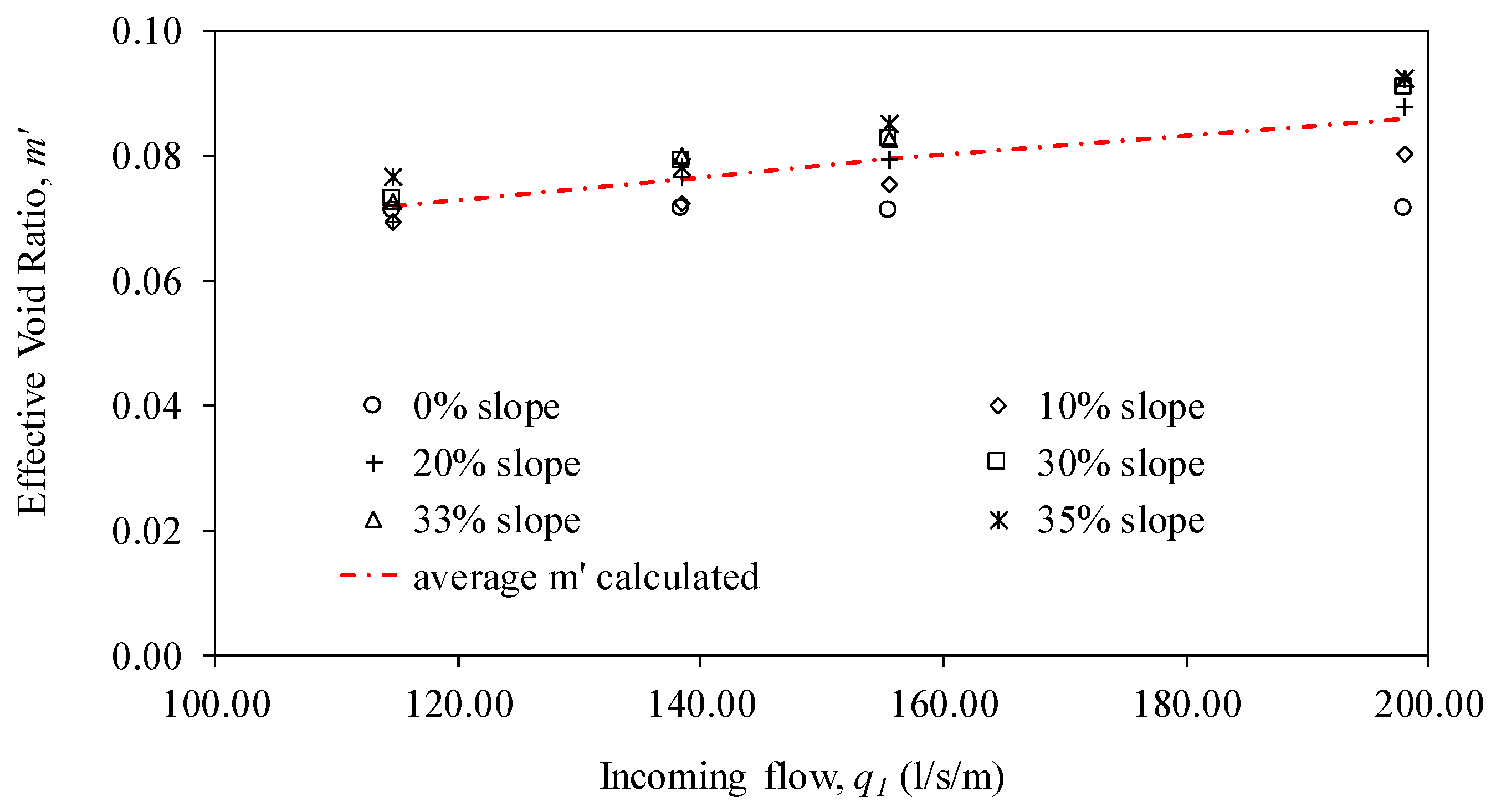
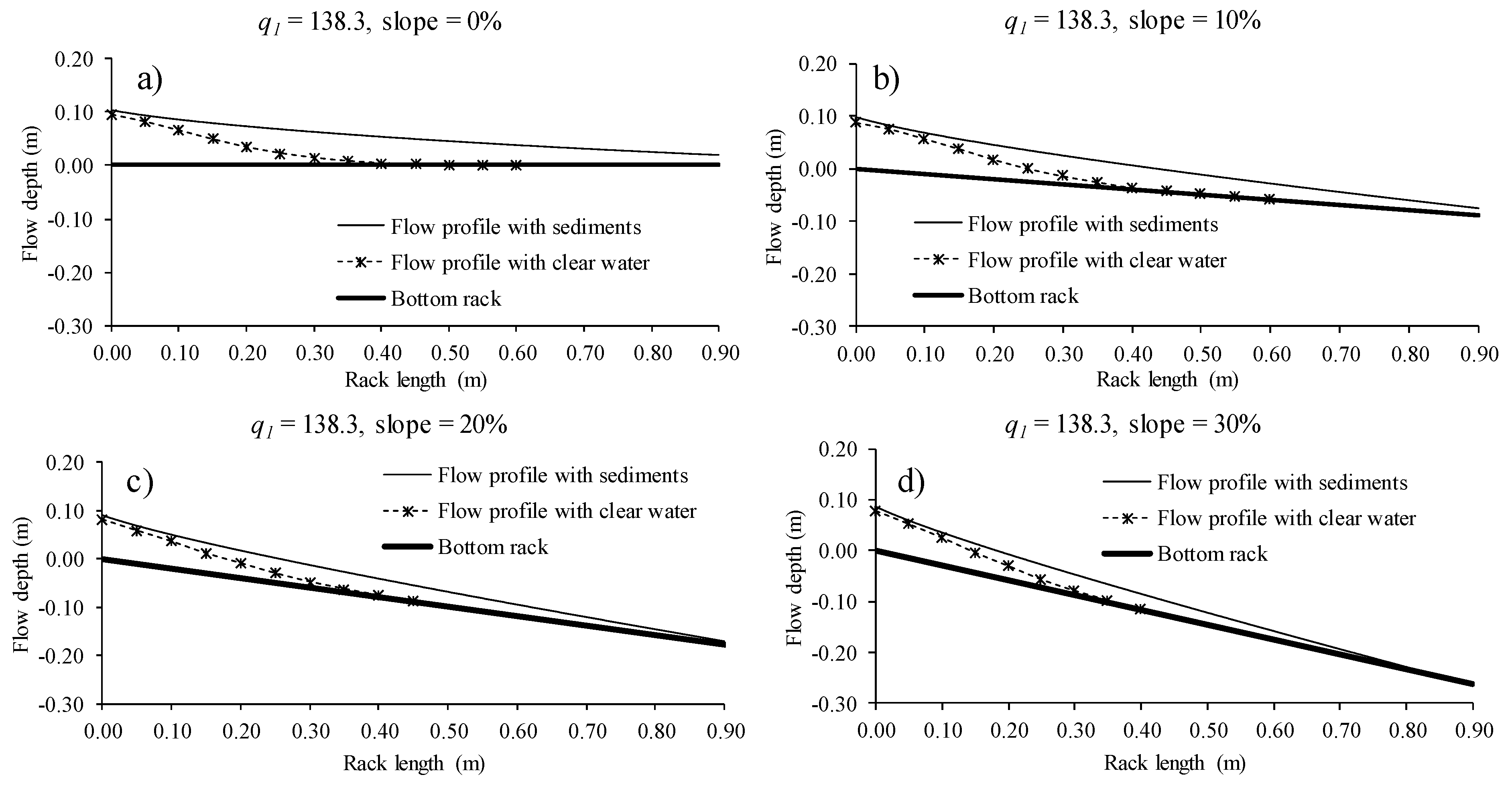

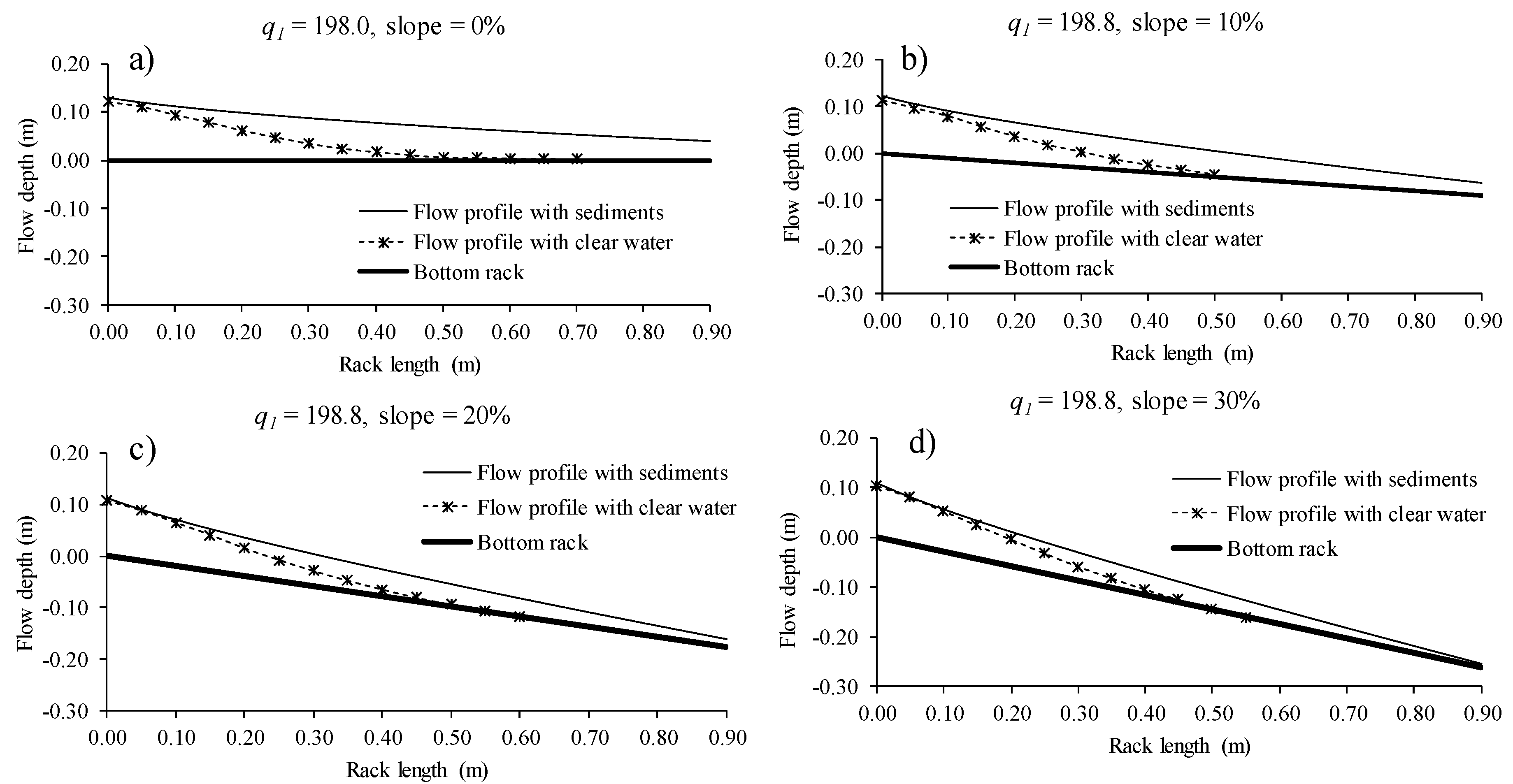

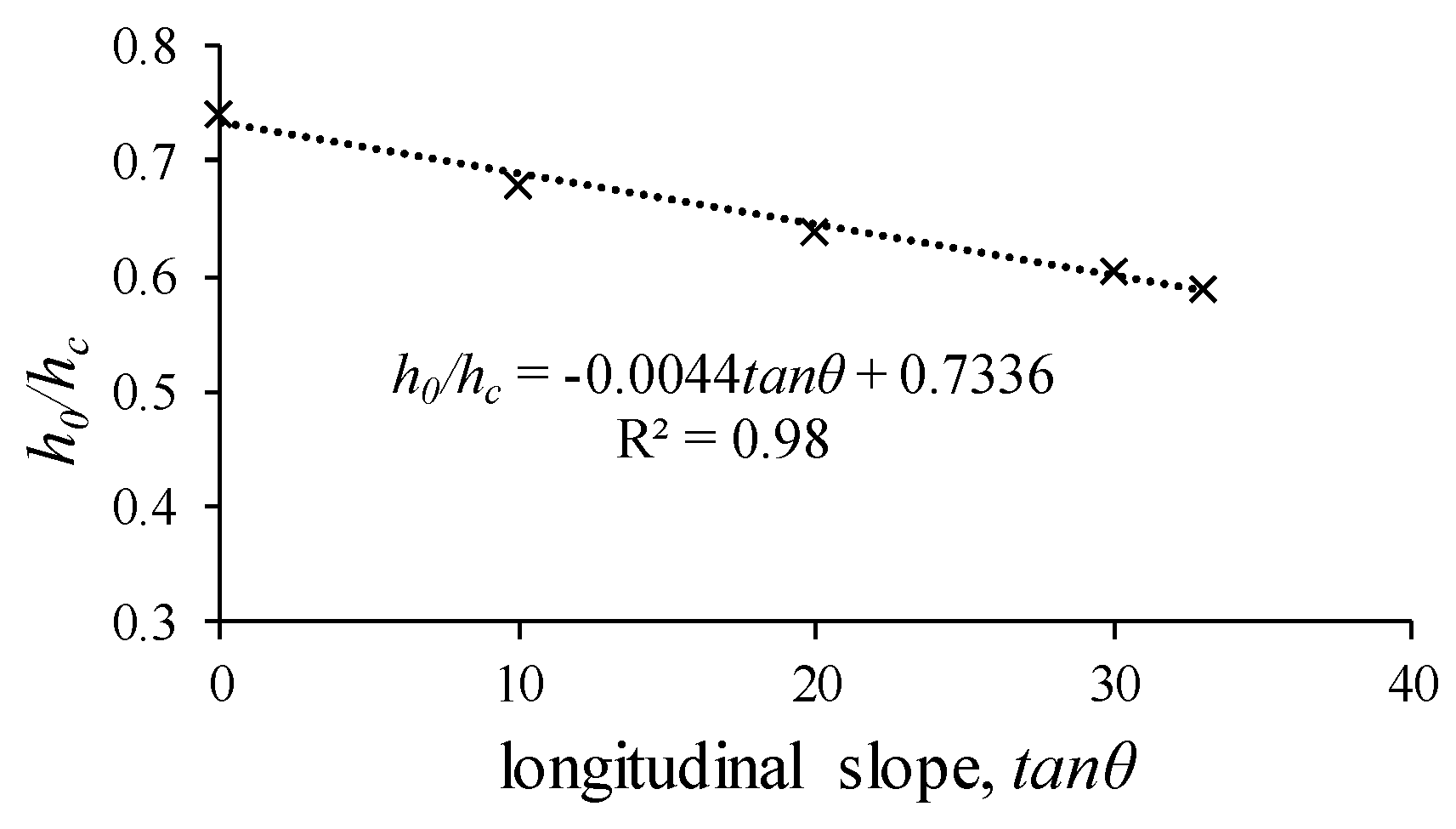
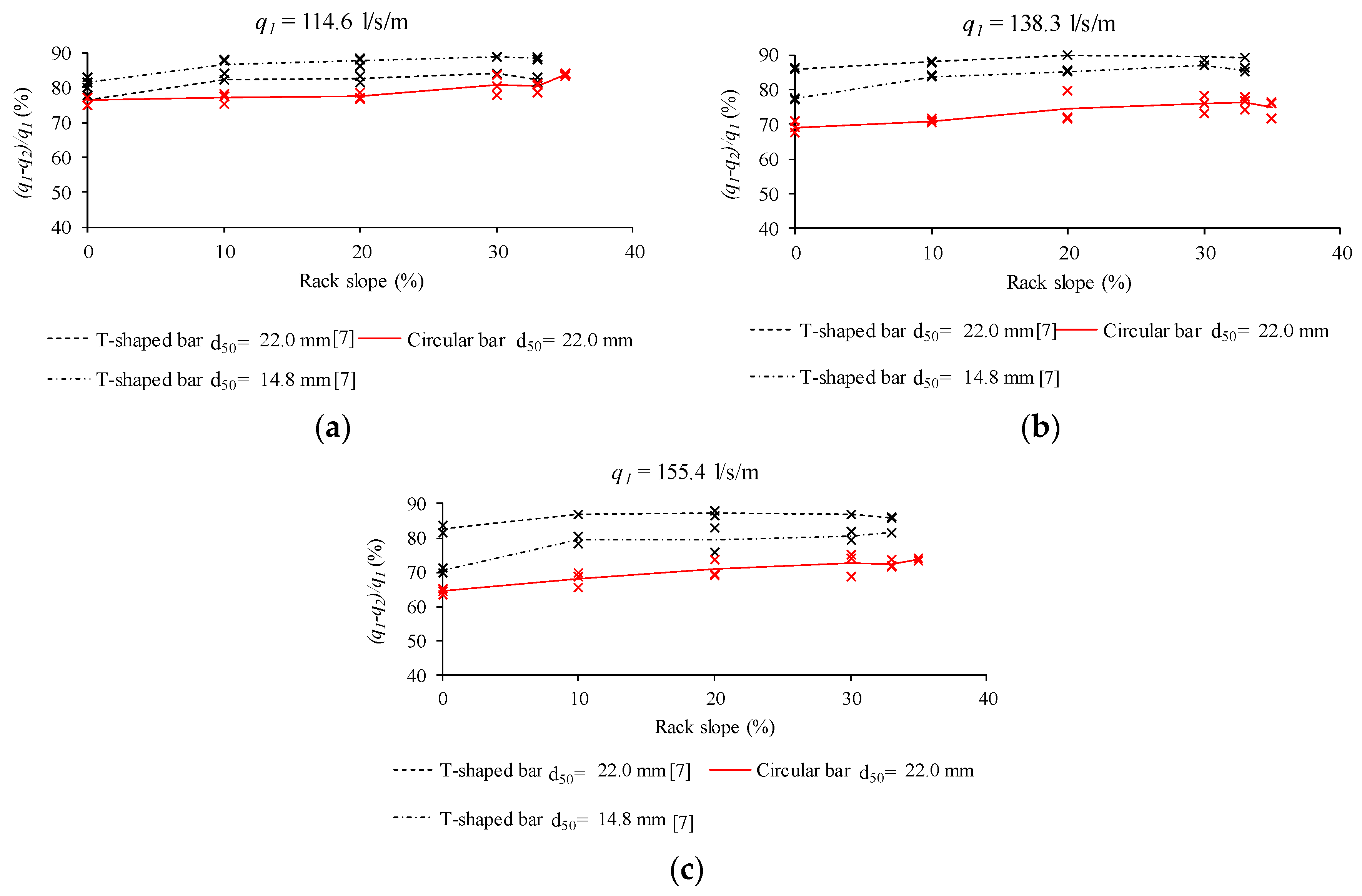
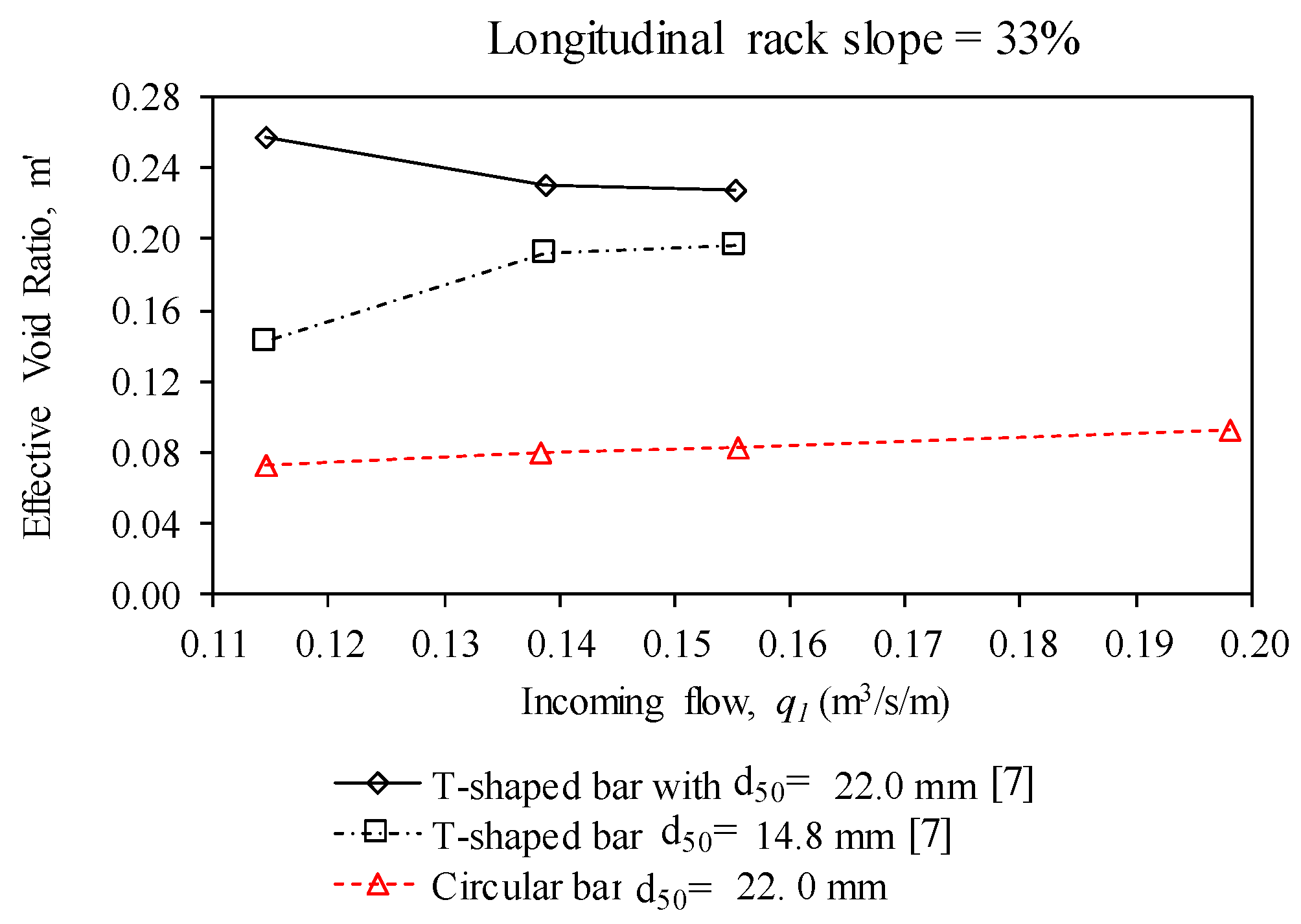
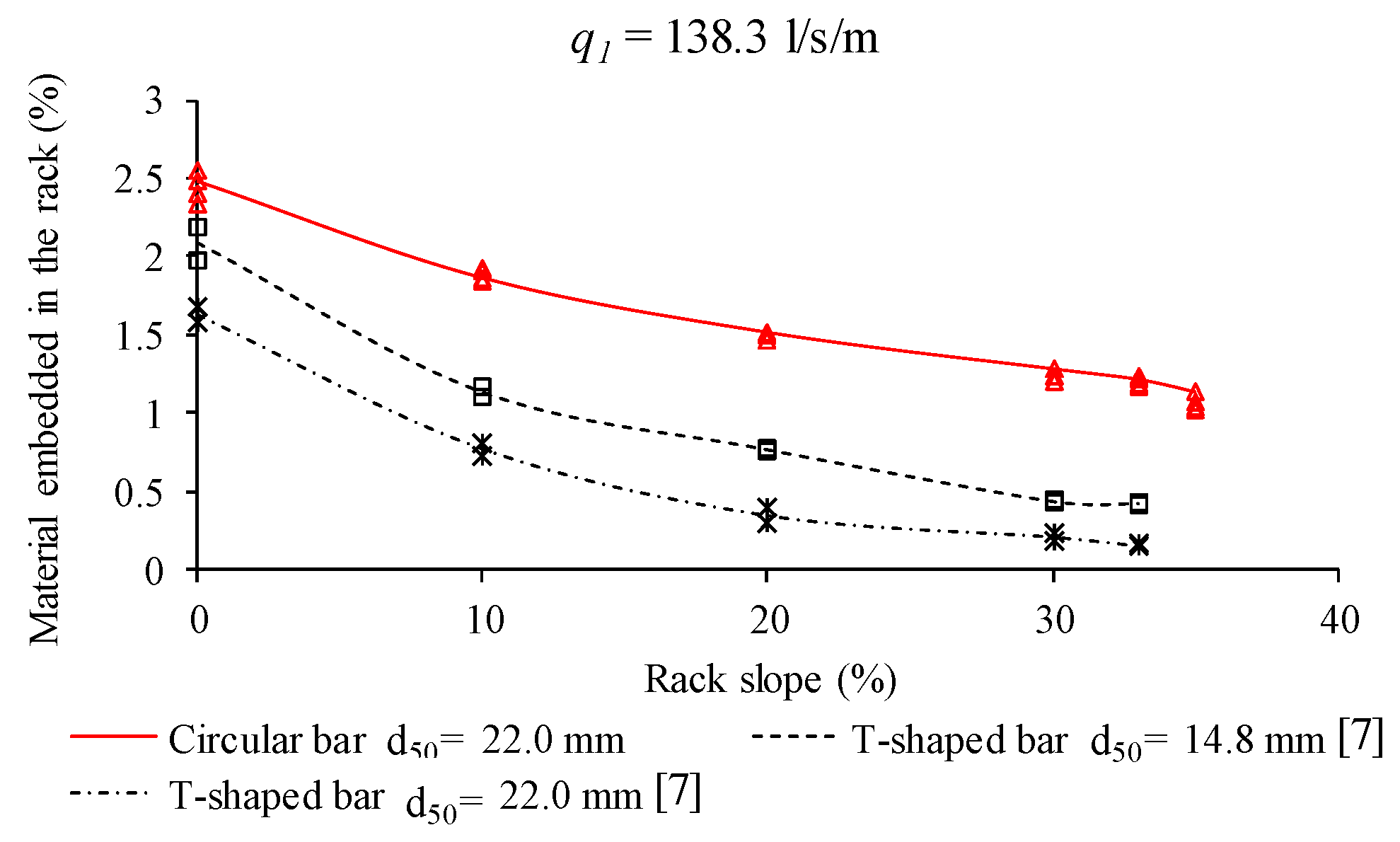
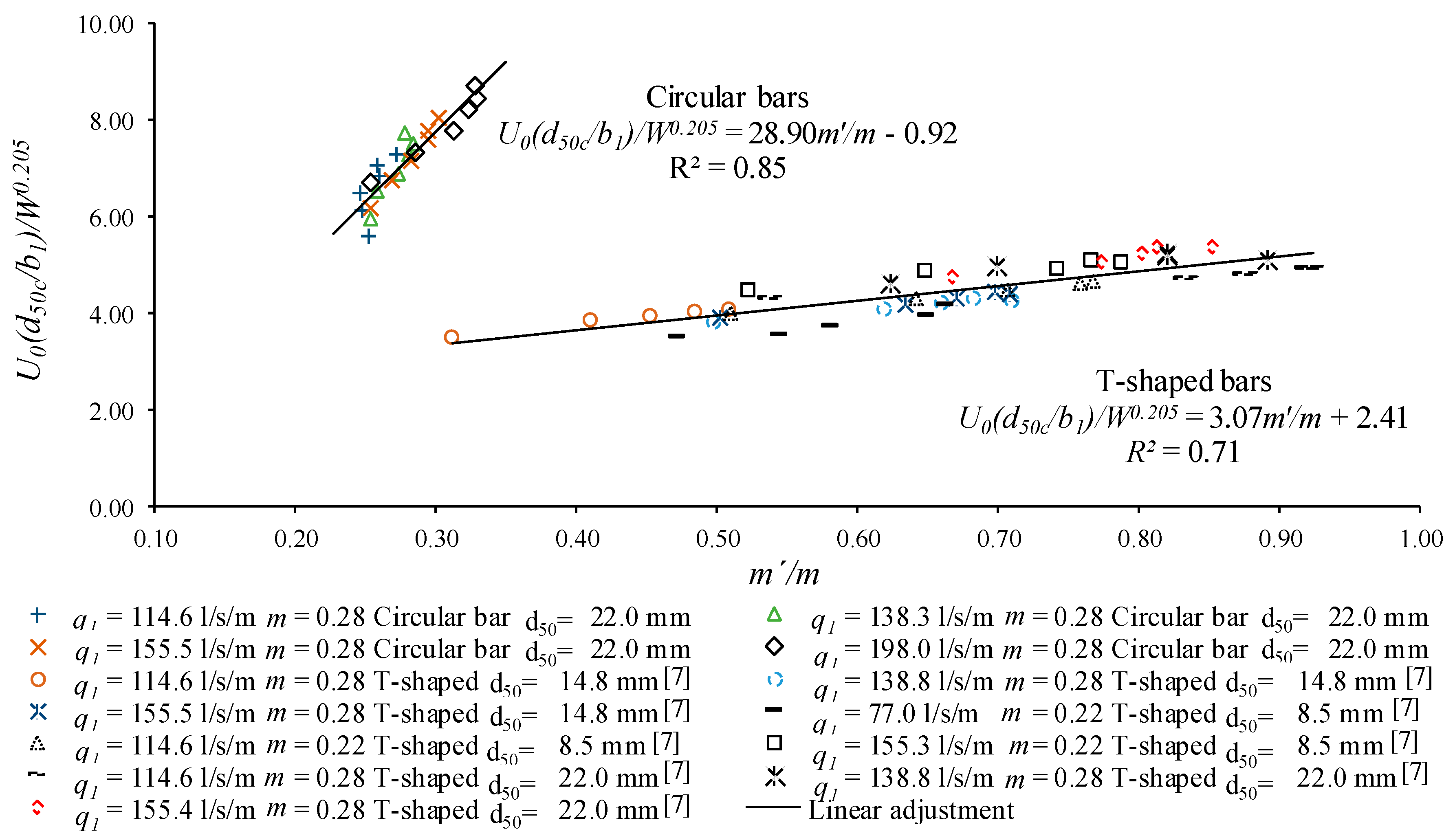
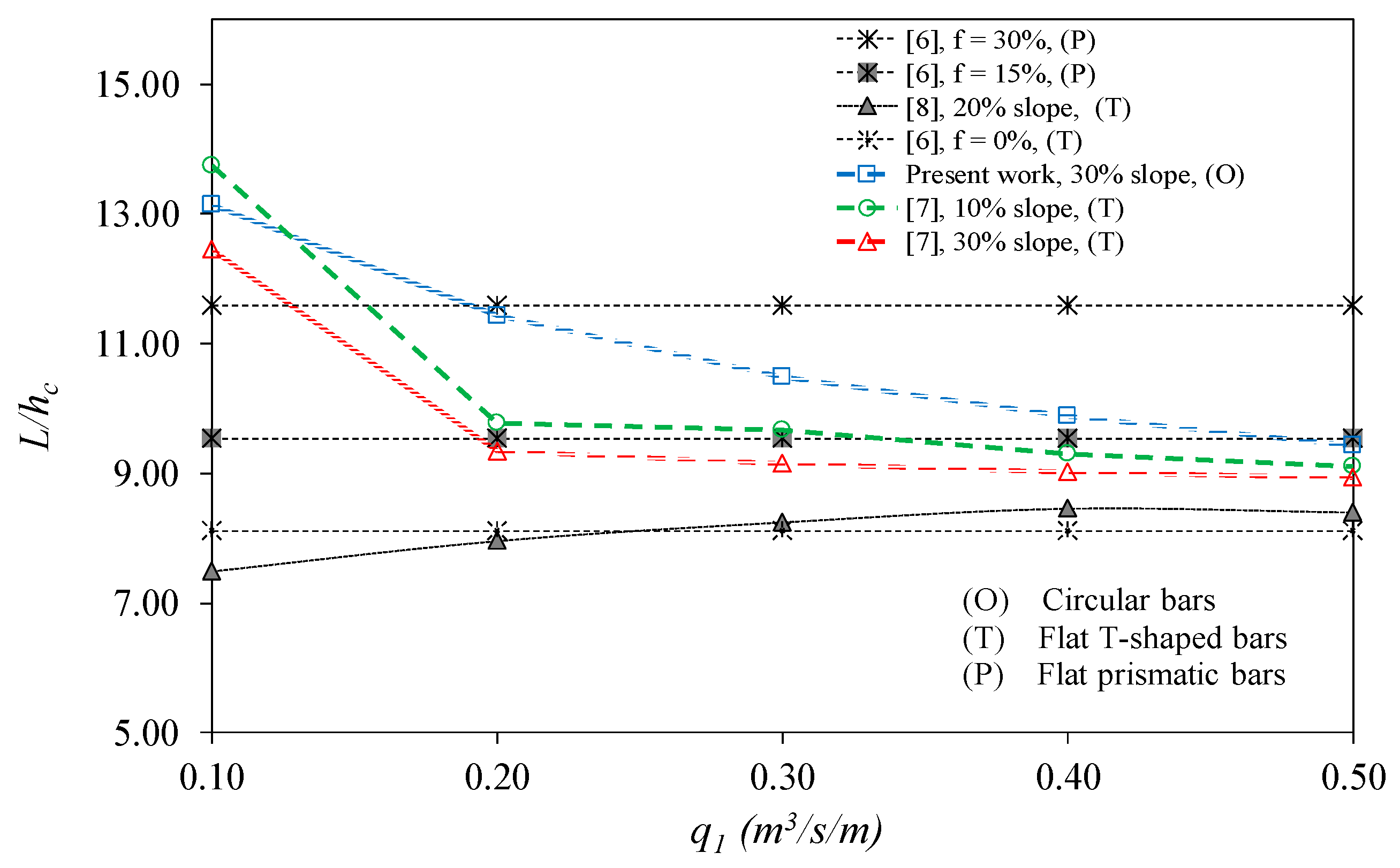
| Author | Bar Space, b1 (m) | Longitudinal Rack Slope (%) | Increment of Rack Length (%) | Obstruction Factor (%) | Bar Profile |
|---|---|---|---|---|---|
| Ract-Madoux et al. [11] | 0.100 | 20 | – | – | Thick trapezoidal, rail-type, round head (next to circular) |
| White et al. [12] | 0.030–0.076 | 20 | – | – | Prismatic heptagon |
| Krochin [6] | 0.020–0.060 | 20 | – | 0.15–0.30 | Prismatic |
| Simmler [13], Drobir [5] | 0.150 (d95 = 0.060) | 20–30 | 0.50–1.00 | – | Several rounded profiles (next to circular) |
| Lauterjung and Schmidt [1] | – | 9–70 | 0.20 | – | Same as Reference [13] |
| Bouvard [14] | 0.100–0.120/0.002–0.03 SHP | 30–60 | 0.50–1.00 | – | Same as Reference [11] |
| Raudkivi [15] | >0.005 | 20 | – | – | Trapezoidal, inverted railway tracks |
| Andaroodi and Schleiss [2] | 0.020–0.040 SHP | 84–100 | 0.20 | – | Bulb-ended, round head |
| Castillo et al. [7], Carrillo et al. [16], Castillo et al. [17], García [18] | 0.006–0.045 | 30 | – | 0.30 | T-shaped |
| Description | Rack Length (m) | Rack Width (m) | Bar Type (mm) | Width of the Bars, bw (mm) | Direction of the Bars | Spacing between Bars, b1 (mm) | Void Ratio | Longitudinal Slope (%) |
|---|---|---|---|---|---|---|---|---|
| Present work | 0.90 | 0.50 | O30/30 | 30 | Longitudinal | 11.7 | 0.28 | 0, 10, 20, 30, 33, and 35 |
| Previous works [7] | 0.90 | 0.50 | T30/25/2 | 30 | Longitudinal | 8.5 | 0.22 | 0, 10, 20, 30, and 33 |
| T30/25/2 | 11.7 | 0.28 |
| d50 (mm) | Blade | Disc | Rod | Sphere |
|---|---|---|---|---|
| 22.0 | 8% | 30% | 19% | 43% |
| Incoming Flow (l/s/m) | Percentage of Derived Flow (%) | |||||
|---|---|---|---|---|---|---|
| Longitudinal Slope (%) | ||||||
| 0 | 10 | 20 | 30 | 33 | 35 | |
| 114.6 | 76 | 77 | 78 | 81 | 80 | 84 |
| 138.3 | 69 | 71 | 74 | 76 | 76 | 75 |
| 155.5 | 64 | 68 | 71 | 73 | 72 | 74 |
| 198.0 | 56 | 62 | 66 | 67 | 67 | 67 |
| Incoming Flow (l/s/m) | Effective Void Ratio | |||||
|---|---|---|---|---|---|---|
| Longitudinal Slope (%) | ||||||
| 0 | 10 | 20 | 30 | 33 | 35 | |
| 114.6 | 0.070 | 0.069 | 0.069 | 0.073 | 0.073 | 0.077 |
| 138.3 | 0.071 | 0.073 | 0.077 | 0.079 | 0.080 | 0.078 |
| 155.5 | 0.071 | 0.075 | 0.079 | 0.083 | 0.083 | 0.085 |
| 198.0 | 0.072 | 0.080 | 0.088 | 0.091 | 0.092 | 0.092 |
| Case | q1 (m3/s/m) | L1m (m) | L1m′ (m) | Lm (m) | Lm − L1m (m) | Lm − L1m + L1m′ (m) | Lm′/hc (m) |
|---|---|---|---|---|---|---|---|
| T-shaped bars, 10% slope | 0.100 | 0.62 | 1.18 | 0.82 | 0.20 | 1.38 | 13.75 |
| 0.200 | 1.02 | 1.32 | 1.26 | 0.24 | 1.56 | 9.78 | |
| 0.300 | 1.32 | 1.72 | 1.62 | 0.30 | 2.02 | 9.66 | |
| 0.400 | 1.64 | 2.06 | 1.94 | 0.30 | 2.36 | 9.29 | |
| 0.500 | 1.90 | 2.36 | 2.22 | 0.32 | 2.68 | 9.11 | |
| T-shaped bars, 30% slope | 0.100 | 0.66 | 0.94 | 0.97 | 0.31 | 1.25 | 12.45 |
| 0.200 | 1.08 | 1.08 | 1.49 | 0.41 | 1.49 | 9.34 | |
| 0.300 | 1.44 | 1.44 | 1.92 | 0.48 | 1.92 | 9.15 | |
| 0.400 | 1.76 | 1.76 | 2.29 | 0.53 | 2.29 | 9.02 | |
| 0.500 | 2.04 | 2.04 | 2.63 | 0.59 | 2.63 | 8.92 | |
| Circular bars | 0.100 | 0.35 | 1.03 | 0.65 | 0.30 | 1.32 | 13.14 |
| 0.200 | 0.56 | 1.40 | 0.99 | 0.43 | 1.83 | 11.44 | |
| 0.300 | 0.74 | 1.66 | 1.28 | 0.54 | 2.20 | 10.49 | |
| 0.400 | 0.895 | 1.88 | 1.52 | 0.63 | 2.51 | 9.89 | |
| 0.500 | 1.04 | 2.07 | 1.75 | 0.71 | 2.78 | 9.44 |
© 2018 by the authors. Licensee MDPI, Basel, Switzerland. This article is an open access article distributed under the terms and conditions of the Creative Commons Attribution (CC BY) license (http://creativecommons.org/licenses/by/4.0/).
Share and Cite
Garcia, J.T.; Castillo, L.G.; Haro, P.L.; Carrillo, J.M. Occlusion in Bottom Intakes with Circular Bars by Flow with Gravel-Sized Sediment. An Experimental Study. Water 2018, 10, 1699. https://doi.org/10.3390/w10111699
Garcia JT, Castillo LG, Haro PL, Carrillo JM. Occlusion in Bottom Intakes with Circular Bars by Flow with Gravel-Sized Sediment. An Experimental Study. Water. 2018; 10(11):1699. https://doi.org/10.3390/w10111699
Chicago/Turabian StyleGarcia, Juan T., Luis G. Castillo, Patricia L. Haro, and Jose M. Carrillo. 2018. "Occlusion in Bottom Intakes with Circular Bars by Flow with Gravel-Sized Sediment. An Experimental Study" Water 10, no. 11: 1699. https://doi.org/10.3390/w10111699
APA StyleGarcia, J. T., Castillo, L. G., Haro, P. L., & Carrillo, J. M. (2018). Occlusion in Bottom Intakes with Circular Bars by Flow with Gravel-Sized Sediment. An Experimental Study. Water, 10(11), 1699. https://doi.org/10.3390/w10111699







